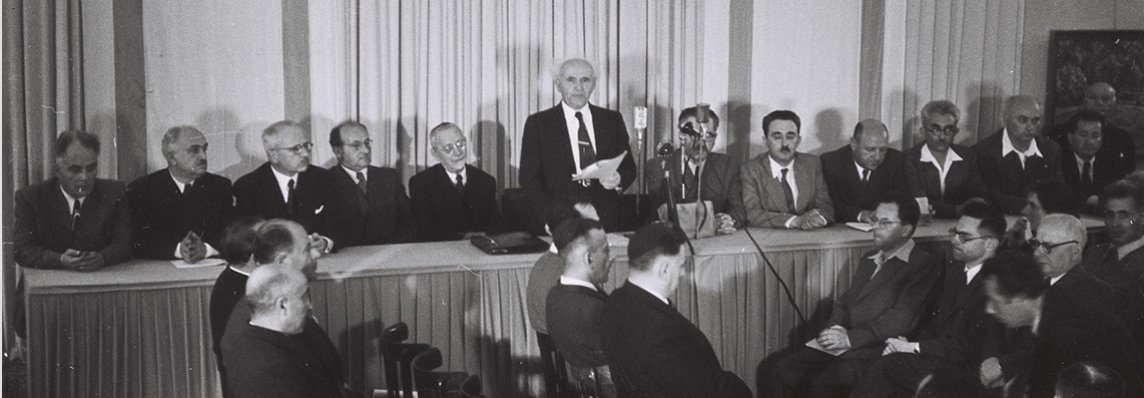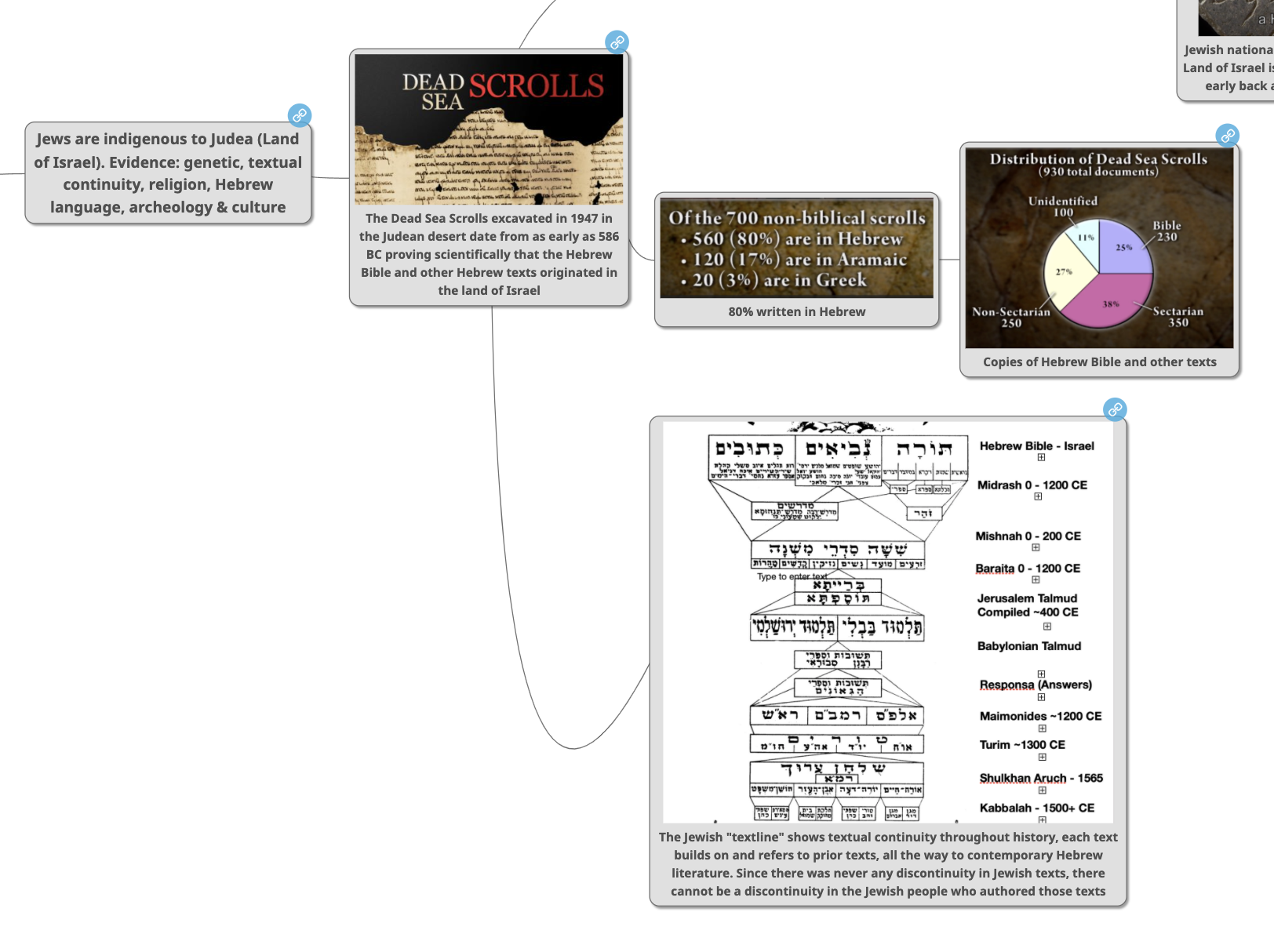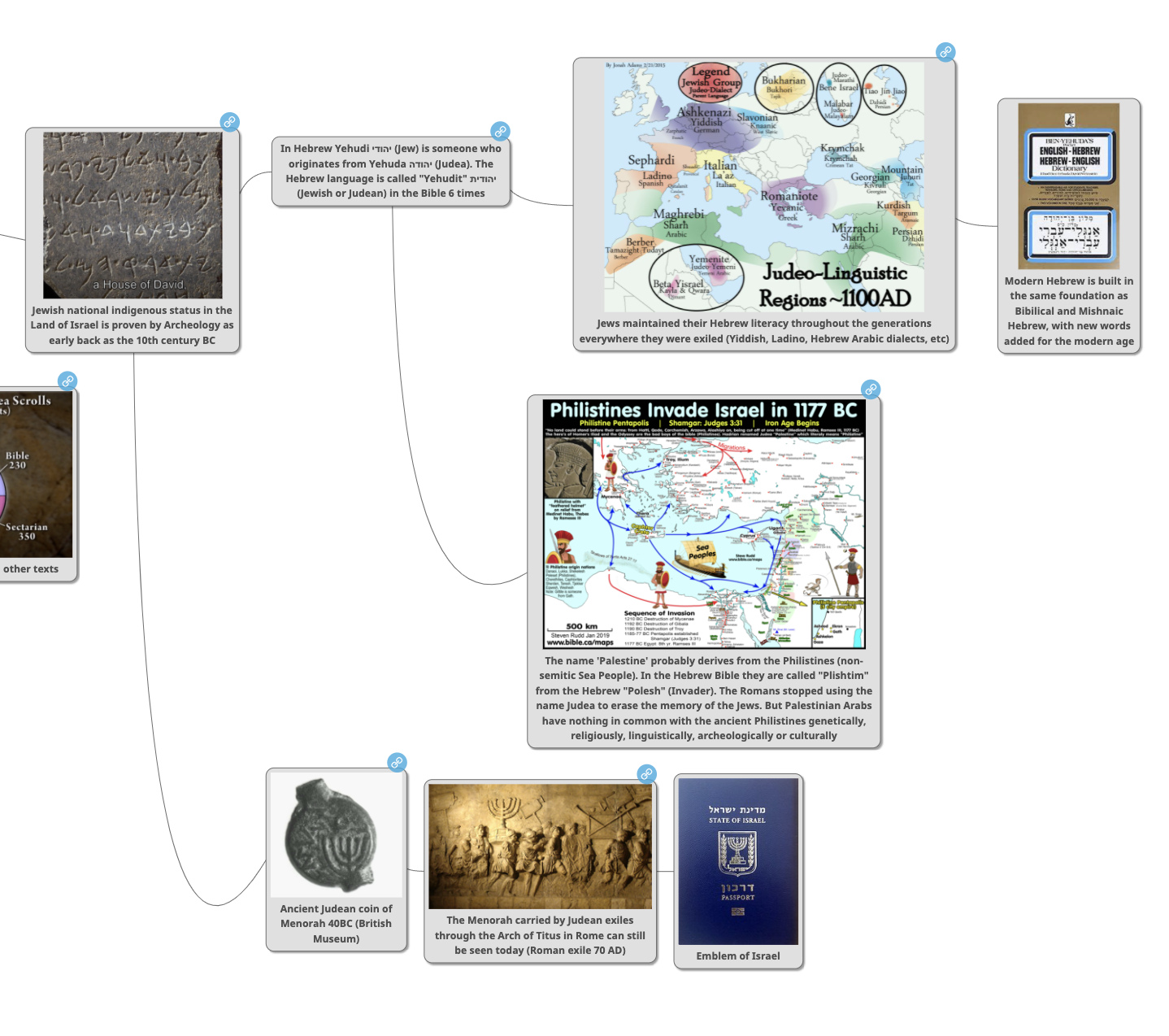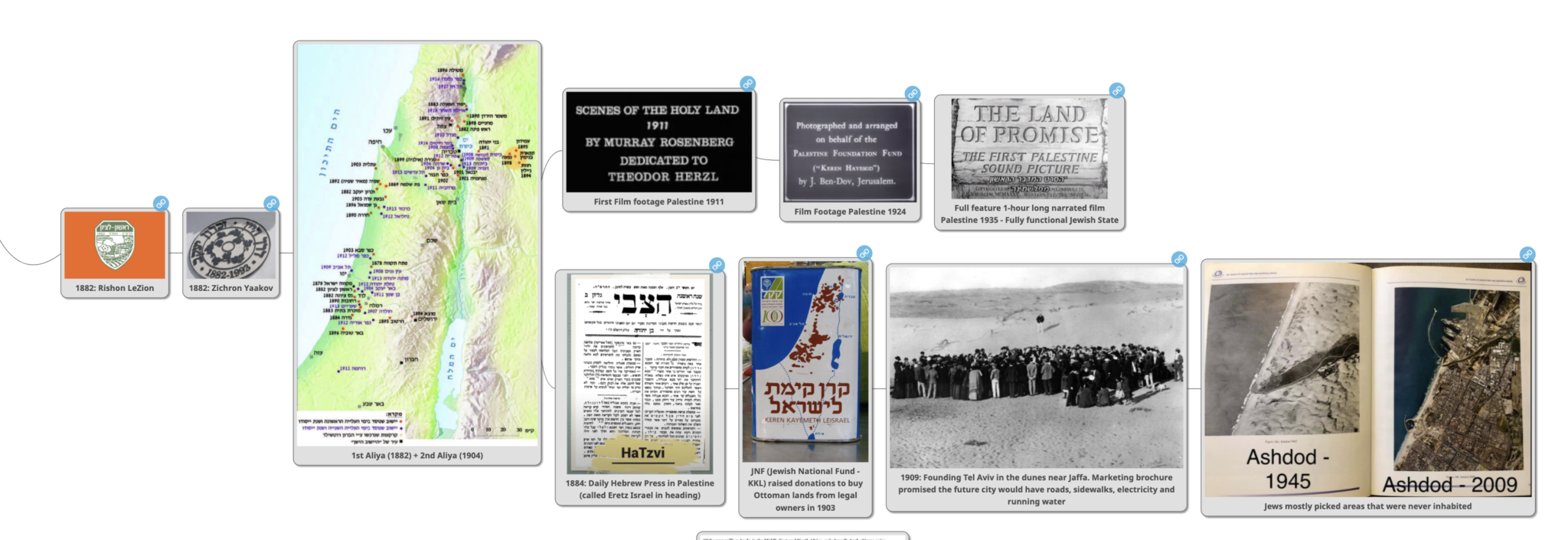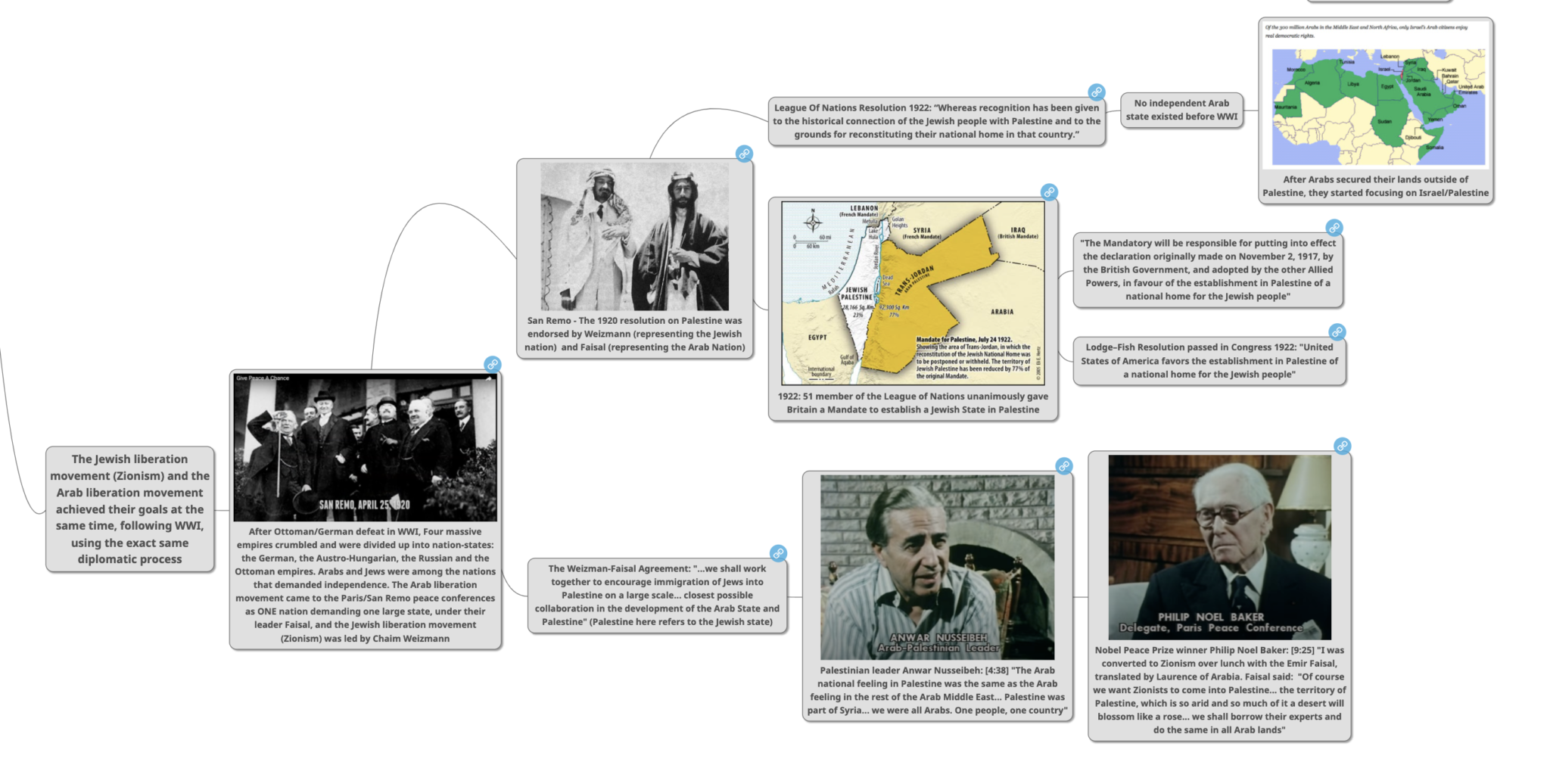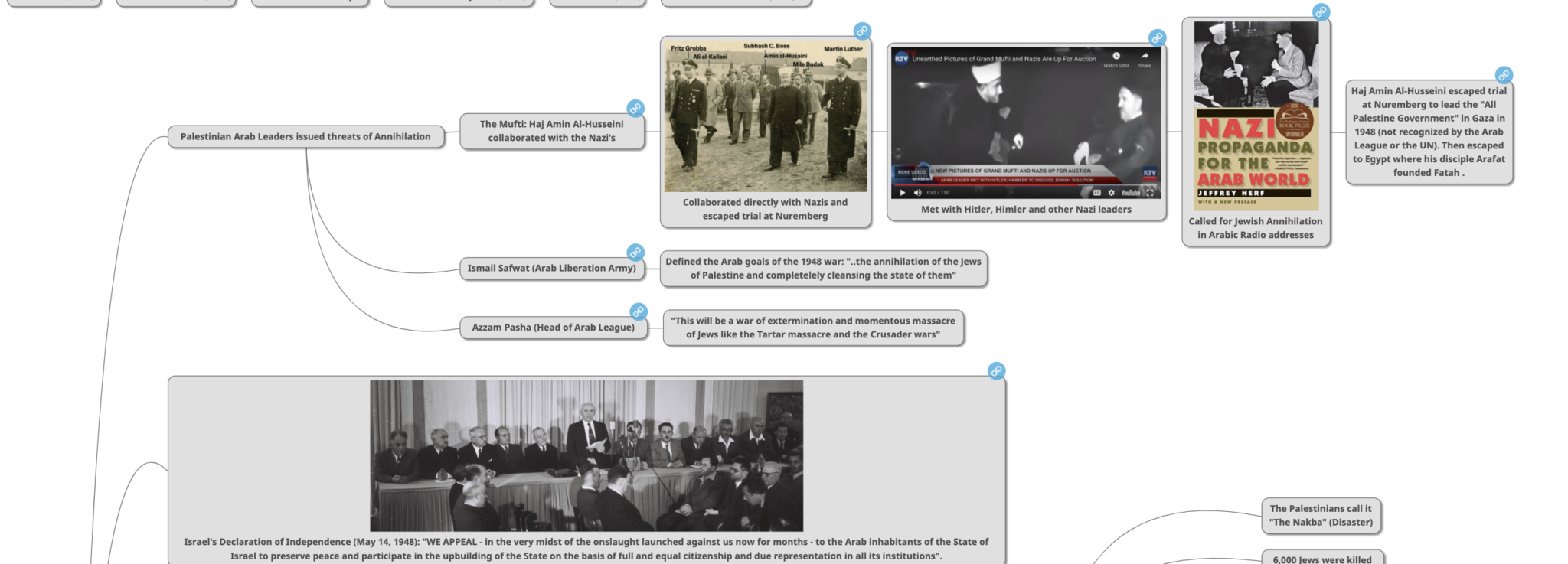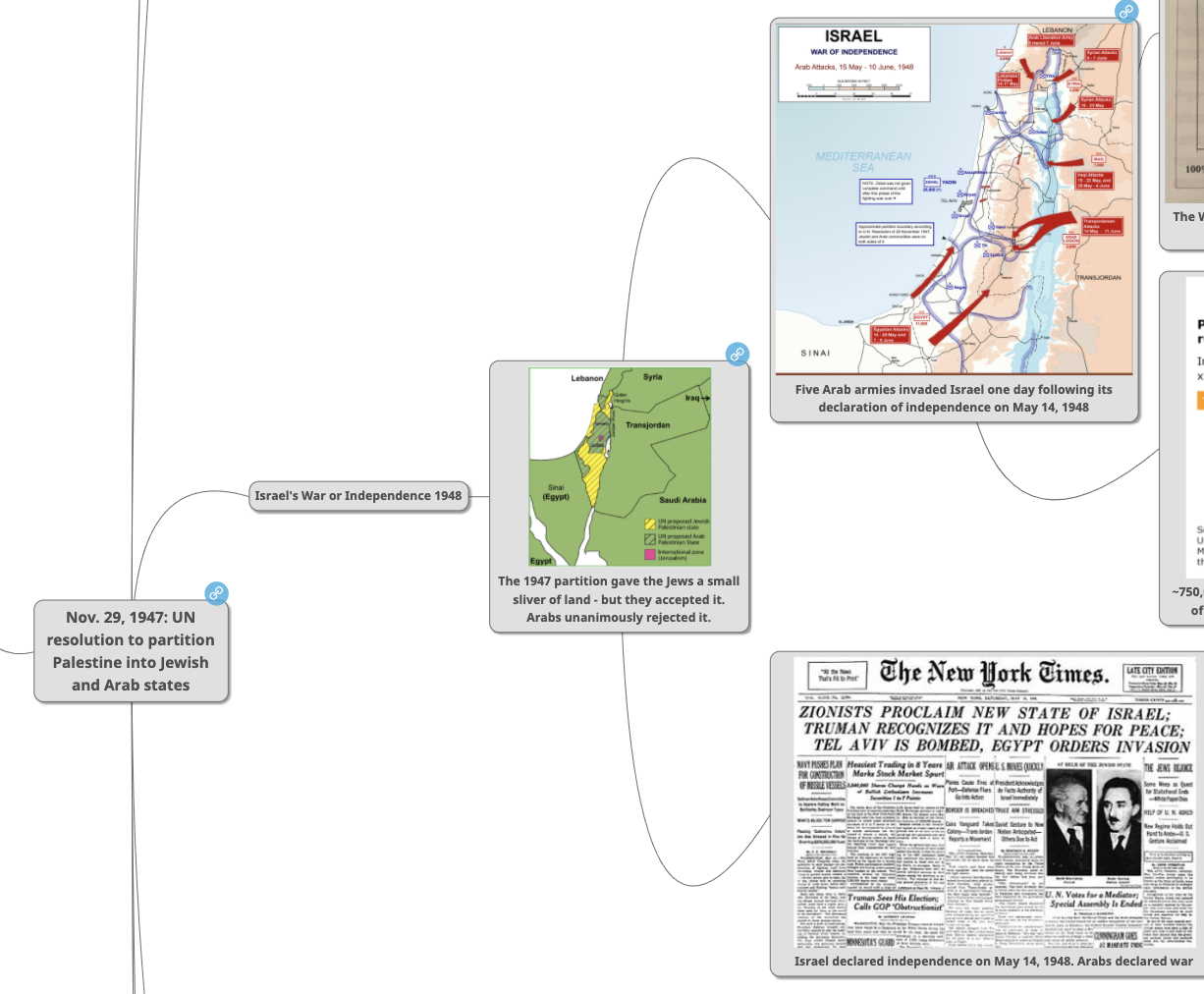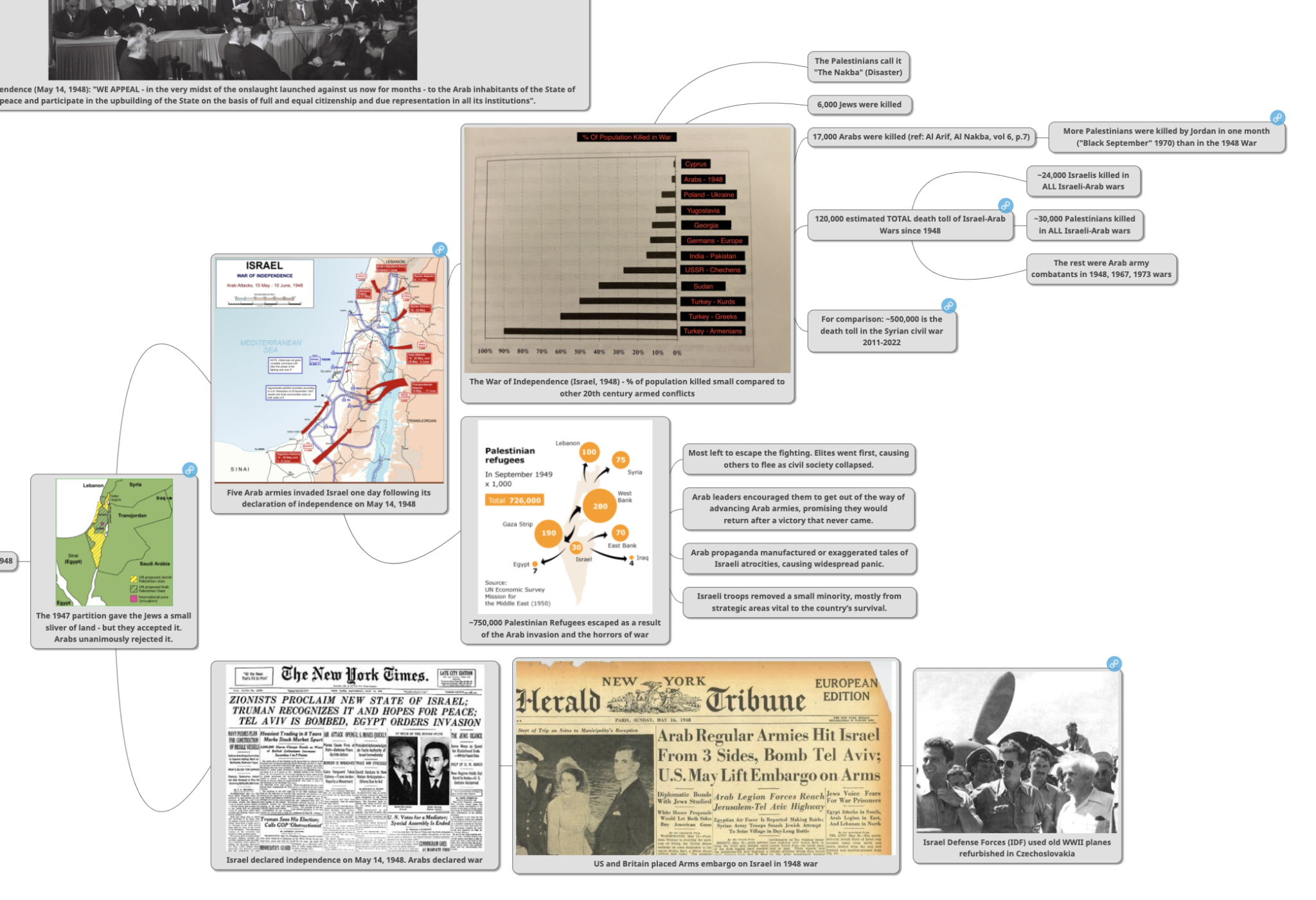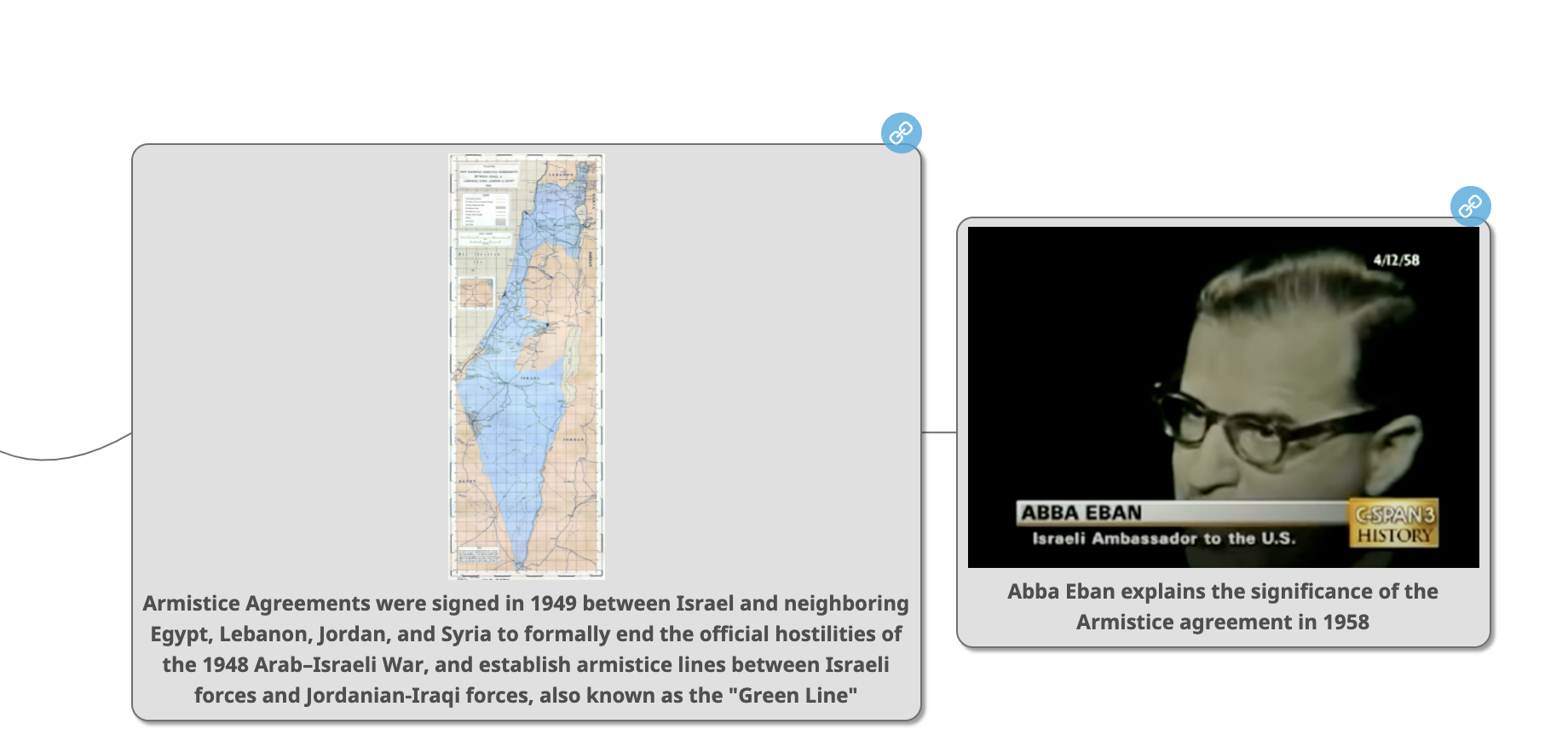MindMaps are a convenient visual representation of complex topics with a lot of inter-connections.
Please click on the following image to view the whole MindMap as a live webpage with active links.
If you are a registered user of the MindMup software, you can also open the MindMap directly via this link.
Below this MindMap you can find a step-by-step walkthrough.
Let’s review the MindMap from top to bottom and left-to-right in sections.
Jews are from Judah
The top-left image establishes Jewish indigenous status in the land of Israel. For secular Jews, this is not based on a biblical promise, but rather on archaeology, history, culture and language. The Hebrew language that is spoken in Israel today is the same language in which the Bible was written. The Dead Sea Scrolls, which were uncovered in the hills above the Dead Sea, prove this beyond any doubt. All Jewish scriptures were based on Hebrew (even Talmudic Aramaic was written in the Hebrew alphabet). The continuity of Jewish text, each generation building on prior generations, all written in Hebrew alphabet, proves the textual continuity of the Jewish people and their roots in the land of Israel. For more details please see my blog: Jews and The Land of Israel.
We Are the Hebrews
The following MindMap section shows how the Hebrew alphabet continued to be used by Jews throughout the diaspora. Many people know that Yiddish is written in Hebrew letters, but there are dozens of other Jewish dialects that were developed all over the world to maintain Jewish continuity.
The same applies to Jewish symbols. The Arch of Titus in Rome (plundered from the Jerusalem Temple) shows the exiles carrying the same 7-branch Jewish Menorah symbol that decorates an Israeli passport today and stands in front of the Knesset – the Israeli Parliament building. This same symbol was also found on countless Judean coins, as can be seen in the British Museum.
The name “Palestine”, given by the Romans, is probably derived from the biblical “Plishtim”, which derives from the Hebrew “Polesh” (Invader). The Romans tried to erase Jewish memory by renaming their land from Judea to Palestina, to show that the invaders have displaced the indigenous Jews. Current day Palestinian Arabs have nothing in common with the Philistines genetically, religiously, linguistically, archeologically or culturally.
If I Forget Thee Jerusalem
Diaspora Jews held on to the memory of the land of Israel in many ways for many generations. A few of them are shown in the MindMap section below. Jewish Holidays have always celebrated the seasons in the land of Israel, not in local lands. Jewish travelers documented life in the land of Israel throughout the centuries of exile.
The daily Jewish prayers have always asked God to return the Jews to their homeland. At the Passover Seder, Jews say: “Next year in Jerusalem!”. The breaking-of-the-glass at a Jewish wedding commemorates of the destruction of the Temple in Jerusalem.
The preservation of the Hebrew language, as mentioned above, was traditionally carried out by teaching Jewish children to read Hebrew letters and texts from the age of 3. Jewish poetry and literature have always expressed the yearning to return to the land of Israel and to Zion (Jerusalem).
The Israeli Anthem “Ha Tikva” expresses the eternal hope of Jews throughout history to return to Zion and to be a free people in their own land: the land of Zion and Jerusalem.
One People, One Land
The following section shows that Jews were the only nation ever to gain independence in the land of Israel. The Hasmonean Jewish state thrived for ~100 years between the Greek and Roman Empire invasions. The Mishnah and Jerusalem Talmud were created in the land of Israel up until the Muslim invasion. When Spain regained its independence from Muslim invasion after 800 years, it was called the “Reconquista” (Reconquer) to remind the Spanish people that they are indigenous in their own land. It took the Jewish people 400 years longer to regain its land back from the Muslim, Crusader, Mamluk and Ottoman invaders. During this whole period, Jews maintained their creativity in the land of Israel. For example, they created the Biblical punctuation and cantillation in Tiberias in the 9th century, and turned Safed into the center of Kabbalah in the 16th century.
The Spring of Nations
The following slice shows why Zionism only became a political movement in the 19th century. The French revolution and the American revolution ushered in the era of Nation States, whereas before there were only Empires and local Feudal rulers. The 1800’s brought about the “Spring of Nations”. Local populations were writing their national narratives in the form of books and newspapers. As Jews kept getting expelled and dispossessed from country to country, Heinrich Graetz wrote a massive 10-volume “History of the Jews” which showed that Jews are a nation living in multiple diasporas rather than just a religion.
Emancipation? Anti-Semitism
As European Nations gained their independence, Jews also started to seek emancipation. They became more secular and studied in general universities. They assimilated, expecting to gain equal rights to the non-Jewish citizens. But that did not happen. A new kind of anti-Semitism arose. Not the religious kind, with which they were all too familiar in Christian Europe and living as Dhimmis under Muslim rule, but a new racial and ethnic hatred specifically targeted towards Jews. Wilhelm Marr coined the term Anti-Semitism, to underscore the racial aspect of Judaism. Jews could renounce their Judaism, but they could not renounce their Semitism. The infamous Protocols of the Elders of Zion fueled anti-semitic vitriol and pogroms in Russia.
Jews realized that they would not be accepted as equals to other nations until they gain their own independence. In 1897 Herzl convened the first Zionist Congress. For the first time ever, 200 Jewish leaders from 17 countries resolved: “Zionism aims at establishing for the Jewish people a publicly and legally assured home in Palestine”.
Modern Zionism
Modern Zionism started to settle the land of Israel around 1882 (a few years ahead of the 1st Zionist congress). Lands in Palestine were purchased legally according to prevailing Ottoman laws. It’s important to remember that the Ottoman Empire ruled Palestine for 400 years, and before that the Mamluk Empire ruled for 300 years. There was never an independent Arab state in Palestine, and none of the ruling Empires were Arab (although they were Muslim). The Palestine Exploration Fund (PEF) created the first modern survey map in 1880. The map showed small sparse Arab villages (marked in red) scattered within a mostly empty land. Mark Twain wrote: “…a desolate country… We never saw a human being on the whole route…”. The population density of Palestine in 1880, when modern Zionism began, was among the lowest in the world. The Ottomans saw Palestine as part of Syria. Only Zionism saw Palestine (aka The Land of Israel) as an independent geographical unit.
Early Zionist towns and villages sprung all over the land of Israel in the 1880’s and into the early 1900’s, long before the British Mandate. Jews never seized any lands by force. All lands were purchased according to local Ottoman law.
The early Zionist settler chose many areas that were empty and considered uninhabitable. They dried swamps and cured malaria in the North, and revived the desert in the South. They raised funds from Jews all over the world through the Jewish National Fund (JNF).
They revived the Hebrew language, formed Hebrew newspapers, and started the modern city of Tel-Aviv in 1909 in the middle of empty sand dunes near Jaffa. The determination of the early Zionists soon turned the barren deserts and mosquito-infested swamps into thriving communities. All of these are amply documented in archival photos and films.
San Remo and the British Mandate
In World War I, the Ottomans sided with the Germans, while the Jews and Arabs mostly sided with the Allies. When the war was over, The Ottoman Empire was dismantled, and the Allies sought to reward the Jews and Arabs – both of whom sought national independence. At the San Remo Conference, King Faisal represented the entire Arab nation, and Haim Weizman represented the Jewish nation. They signed the famous Faisal-Weizman Agreement to form a Jewish state in Palestine.
The San Remo Conference unanimously agreed among the 51 members of the League of Nations (and the US) to establish in Palestine a national home for the Jewish People. Since most Jews did not yet live in Palestine, Britain was given a Mandate to build a Jewish state in Palestine. This became known as the “British Mandate” of 1922, but it’s important to remember what those words mean: Britain received a mandate to create a Jewish national home in Palestine. This entailed encouraging Jewish immigration to Palestine on a large scale, not just relying on the Jews that were already living there.
Partition Plans Fail
Britain never fulfilled its mandate. Instead of allowing Arab immigration to Eastern Palestine (Trans Jordan) and Jewish immigration to Western Palestine (the Land of Israel), they allowed free Arab immigration to both, and placed severe limitations on Jewish immigration to both. Since Jordan remained barren while Jewish Palestine thrived economically, Arab immigration was mainly pouring into Palestine.
As the Arab population continued to grow through economically-driven immigration, all attempts to reach agreements on partitioning the land between Jews and Arabs between 1922 and 1947 failed, because the Arabs violently opposed Jewish sovereignty on any part of the land.
Six different partition plans were proposed (aka “A Two-State Solution”). All were accepted by the Jewish leadership, and all were rejected outright by the Arabs. The Jews never denied that Palestinian Arabs have rightful claims to lands, and always sought a compromise. Zionists were willing to accept almost any partition plan that would give them sovereignty and a Jewish majority even on part of the land. However, the Palestinian Arabs refused to compromise then, just as they refuse to compromise now, as their stated goal was, and still is, to deny Jewish sovereignty on any part of the land.
As World War II raged on and the Nazis perpetrated the Holocaust, the British halted almost all Jewish immigration to Palestine, thereby reneging on their UN mandate to create a Jewish national home, and denying refuge to thousands of Jews who had nowhere to flee.
The Palestinian leader Haj Amin Al-Husseini chose to side with Hitler and the Nazis, and narrowly dodged trial at Nuremberg by escaping back to Egypt and then to Gaza, and regained his status as the Palestinian leader in 1948.
Israel is Born
The Arabs rejected the 1947 UN partition plan, which proposed the so-called “Two-State Solution” for Jews and Arabs, and started a civil war within the borders of Palestine. Arab league leaders threatened Jewish annihilation explicitly, and the British announced that they were leaving Palestine in May 1948. Israel decided to declare its independence within the borders of the UN partition plan on May 14, 1948. It is important to keep in mind that up to that point, no lands, villages or towns were taken forcefully away from the Palestinian Arabs.
The day after Israel declared its independence (see blog about Israel’s Declaration of Independence), 5 Arab armies invaded the newly formed State of Israel, forcing it into a defensive war, fighting for its very existence. The Jordanian and Egyptian armies were armed and trained by the British, but Britain and the US refused to supply any arms to Israel, so it had to import second-hand WWII weapons that were refurbished in Czechoslovakia.
Israel’s War of Independence and Palestinian Refugees
The Arab League invasion of 5 well equipped and trained armies caused a full-scale war that resulted in many casualties on both sides. About 6,000 Jews were killed, many of them recent Holocaust survivors, and 17,000 Arabs. These casualties were a cause for much grief on both sides, but they pale in comparison to other armed conflicts during the same period (e.g. India-Pakistan). More Palestinians were killed by Jordan in the month of Black September in 1970 than during the Israeli War of Independence. And all of these numbers are dwarfed by the number of casualties in the Syrian civil war which is raging for more than a decade.
The Arab invasion of 1948 directly caused the Palestinian refugee problem. No Palestinian Arabs became refugees before the 1948 war and none would have been displaced had the Arabs accepted the partition plan or any of the previous partition plans. The number of Palestinian refugees in 1948 is estimated at 750,000. About 500,000 of them remained in the West Bank and Gaza. They were displaced and resettled in the area west of the Jordan river, so they don’t fit the definition of refugees used by UNHCR since they remained in their borders. The other 250,000 should have been absorbed in the Arab neighbor countries to which they fled, but many were deliberately kept separate, and were not granted equal citizenship.
Armistice 1949
Israel’s War of Independence ended in 1949 with the signing of Armistice Agreements between Israel and its Arab neighbors. The link to the 1958 Aba Eban Interview below explains this in detail. In spite of agreeing to these borders, Israel’s Arab neighbors forced Israel to defend itself again and again in a series of existential wars. These wars, instigated by Egypt, Syria, Lebanon, Jordan and Iraq, were not about the rights of the Palestinian Arabs – they were simply attempts to annihilate Israel. For the 20 years from 1948-1967, when Jordan ruled the West Bank and Egypt ruled Gaza, there was never a single attempt to give the Palestinians any form of sovereignty or independence. That demand was only ever made of Israel.
Jewish Refugees from Arab Lands
During and after the 1948 war, the Arab League countries that lost the war started victimizing and expelling their Jewish citizens in retaliation for the Jewish victory in Palestine. Many of the Arab Jews had lived in their host countries for centuries, yet about 850,000 of them were deliberately expelled and all their possessions seized. Most found their home in Israel, while some scattered to Europe and the US.
Israel made efforts to absorb all displaced Jewish citizens, whether they were Holocaust survivors from Europe or expelled Arab Jews. Unfortunately, the Arab countries did nothing to absorb the Palestinian Arab refugees. On the contrary. They coerced the UN to create a separate organization, UNRWA, separate from UNHCR which deals with all other refugees, to perpetuate the refugee status of Palestinian Arabs and their descendants, who claim a right of return to Israel. Such a right does not exist, and has never been invoked in any other conflict. The UNRWA agency has enormous budgets which do not go towards resettling and absorbing Palestinians, but rather into perpetuating their refugee status for generations.
The War of Return
Thus we have absurdities like the picture on the right, where a refugee camp exists side-by-side with the bustling Palestinian city of Ramallah. The book The War or Return and this video by the authors, explains how this perpetuation of the “refugee status” to all Palestinian descendants for all future generations, and the West’s indulgence around the Palestinian demand for “return” into Israel are the biggest obstacles to peace. Israel cannot allow an ever-growing number of Palestinian descendants to flood into its borders, as that would make the Jews a minority in an Arab majority state. There are already 22 Arab states within the Arab League. “Justice” does not require the one and only tiny Jewish state to turn into a 23rd Arab League country. That is why a Two-State solution remains the only way Jewish sovereignty can be maintained alongside a demilitarized Palestinian Arab state.
Peace Efforts Keep Failing
Israel continues to offer the Palestinians a Two-State Solution, but Palestinians have always rejected such offers. Before 1948 and after. In each case, Palestinians have responded to peace offerings with suicide bombings, rockets and violence.
The latest round of negotiations between Israel and the Palestinians ended with the 2014 Gaza War. After 2 years of negotiations during the Obama/Kerry administration in 2013-2014, the Palestinian leader Abbas “exploded with rage” at Kerry over his “insane” framework proposals. He then sought reconciliation with Hamas (which failed), and by then the situation in Gaza escalated to a full-scale war.
More Resources
For more information about Zionism and the Arab-Israeli conflict, please see my Zionism and Israel – Historical Learning Resources. It has a list of recommended books, historical video clips, organizations, articles and maps to help you navigate this complex topic.
Hope for the Future
To end on a more positive hopeful note, here is Dr. Einat Wilf’s recent lecture entitled “Arab Zionism and the Path to Peace”:
